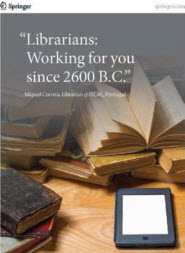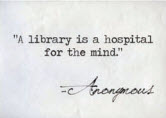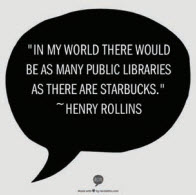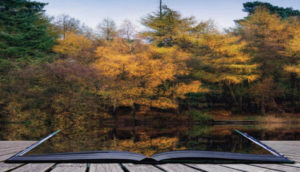 Libraries are important to all of us involved in publishing in general, and scholarly and scientific publishing specifically, for several reasons. Their resources are often the first stop for researchers and scholars when starting a new project and a frequent source of additional information throughout. Without library book buyers and journal subscribers, many a worthy set of research results would not be accessible to as large of an audience as an author would hope. And without the library, many a worthy book or journal might not even be in existence at all given that more rather than fewer academic publishers have become financially dependent on institutions. Libraries have taken on many new roles of late as well. Some are partnering with university presses to develop new journals and other publications. Still others administer platforms for electronic publishing and might even be considered publishing operations in their own right. In this column, I’ve collected some quotes that provide you with a view of research libraries in the twenty-first century as seen by leaders in the field. The first is a view from two decades ago; the others have come about in the present day with one of those looking quite far into the future.
Libraries are important to all of us involved in publishing in general, and scholarly and scientific publishing specifically, for several reasons. Their resources are often the first stop for researchers and scholars when starting a new project and a frequent source of additional information throughout. Without library book buyers and journal subscribers, many a worthy set of research results would not be accessible to as large of an audience as an author would hope. And without the library, many a worthy book or journal might not even be in existence at all given that more rather than fewer academic publishers have become financially dependent on institutions. Libraries have taken on many new roles of late as well. Some are partnering with university presses to develop new journals and other publications. Still others administer platforms for electronic publishing and might even be considered publishing operations in their own right. In this column, I’ve collected some quotes that provide you with a view of research libraries in the twenty-first century as seen by leaders in the field. The first is a view from two decades ago; the others have come about in the present day with one of those looking quite far into the future.
20 Years Ago
 “The Idea of the Library in the Twenty-First Century” is the title of a Janet Doe Lecture by Nina Matheson, director emerita of the Welch Medical Library at Johns Hopkins University published in 1995. Her primary focus was on the concept of knowledge, about which she wrote: “There is no way to get an orderly display of knowledge in any specific domain. There are only little peepholes to some portion of the elephant known as a discipline.” Building on Peter Drucker’s concept of “knowledge capitalism,” Matheson predicted that “knowledge in the next era is a capital resource. The talent and ability to apply knowledge to create knowledge and to organize it for useful purposes will be fundamental to the survival and growth of organizations as well as individuals.” She further reviewed the differences among publishing to provide entertainment versus that eventually housed in scholarly, scientific, research, or professional libraries. Matheson’s penultimate comments relating to the title of her lecture were: “The idea of the library is no longer the mausoleum of dead genius as it had been in the nineteenth century. In the twentyfirst century, the idea of the library will be a knowledge server, an encyclopedic source of knowledge, the encryption of what is known of civilization, culture, and the organization of the universe. In the twenty-first century… [t]hese knowledge sources, some of which will still be called libraries, must be dedicated to information and to knowledge; their storage, acquisition, dissemination; and their management over all time. These knowledge sources must be specialized in both function and scope, and they must be the intellectual responsibility of those responsible for creating knowledge.”
“The Idea of the Library in the Twenty-First Century” is the title of a Janet Doe Lecture by Nina Matheson, director emerita of the Welch Medical Library at Johns Hopkins University published in 1995. Her primary focus was on the concept of knowledge, about which she wrote: “There is no way to get an orderly display of knowledge in any specific domain. There are only little peepholes to some portion of the elephant known as a discipline.” Building on Peter Drucker’s concept of “knowledge capitalism,” Matheson predicted that “knowledge in the next era is a capital resource. The talent and ability to apply knowledge to create knowledge and to organize it for useful purposes will be fundamental to the survival and growth of organizations as well as individuals.” She further reviewed the differences among publishing to provide entertainment versus that eventually housed in scholarly, scientific, research, or professional libraries. Matheson’s penultimate comments relating to the title of her lecture were: “The idea of the library is no longer the mausoleum of dead genius as it had been in the nineteenth century. In the twentyfirst century, the idea of the library will be a knowledge server, an encyclopedic source of knowledge, the encryption of what is known of civilization, culture, and the organization of the universe. In the twenty-first century… [t]hese knowledge sources, some of which will still be called libraries, must be dedicated to information and to knowledge; their storage, acquisition, dissemination; and their management over all time. These knowledge sources must be specialized in both function and scope, and they must be the intellectual responsibility of those responsible for creating knowledge.”
Present Day
Blurring Lines
 Two librarians, one publisher, and one library service vendor came together at the 2013 Charleston Library Conference. Their panel was titled “Content, Services, and Space: The Future of the Library as Lines Blur” (published as a Purdue e-Pub dx.doi.org/10.5703/1288284315235). I share with you here one thought from each presenter.
Two librarians, one publisher, and one library service vendor came together at the 2013 Charleston Library Conference. Their panel was titled “Content, Services, and Space: The Future of the Library as Lines Blur” (published as a Purdue e-Pub dx.doi.org/10.5703/1288284315235). I share with you here one thought from each presenter.
Rick Anderson, associate dean for Scholarly Resources and Collections, University of Utah Libraries
“Libraries are starting to become publishers. This is happening in a couple of ways: first, an increasing number of libraries are beginning to actually publish journals that are based on content in their institutional repositories. … It is also true that … they are digitizing and making publicly available rare and unique resources that would otherwise have never been made available to the general public. … Right now we have got somewhere between 20 and 30 university presses that are located in their campus libraries.”

Stephen Rind-Tutt, president, Alexander Street Press
“We have an enormous amount of creation going on in our society, and much of it does not fit in books and journals, yet librarians have all of the skill sets necessary to really make value and really to help society.”
Nancy Gibbs, head, Acquisitions Department, Duke University Libraries
“My blurring line seems to be discovery of new content outside of the library catalog that I would like to purchase, but how do I provide for those models [the next step after traditional PDA], and what do I do when I am trying to purchase it?
Heather Staines, vice president, Publisher Development, SIPX, Inc.
“Working with a number of university presses, one of the interesting things associated with this that I see is actually the library and the press both being put into the IT department at universities where that was not the case even just a few years back.”
Libraries as Publishers
Charles Watkinson, director at the University of Michigan Press and associate university librarian for Publishing at the University of Michigan Library, posted to his blog in January 2015 (charleswatkinson. blogspot.com/) “Three Challenges of Pubrarianship.” He wrote about a movement toward having university presses reporting to the university library and “… also a trend toward increasing integration of the two entities. Physical collocation of staff with both library and press backgrounds, joint strategic planning exercises, and shared support infrastructure…” He defends his neologism with the following: “As libraries move to engage with the inputs as well as outputs of scholarship, and as publishers migrate from processing content to also providing the tools through which it is created, our joint capacity to serve the needs of scholars at all stages of their professional lives grows exponentially. The new pubrarians, whether they arrive in their roles through press/library collaboration or the organic growth of library publishing, may be at the forefront of creating such solutions. And that’s an opportunity worth minting a new word for.”
Current Project = Future Library
This is probably one of the most fascinating library-related items I have ever found. A patroness, one Katie Paterson, a Scottish artist, is the force behind a fantastic publishing→library artwork pro ject that won’t be completed until 2114. Here is the description given on the project’s website:
Scottish artist Katie Paterson has launched a 100-year artwork—Future Library— Framtidsbiblioteket—for the city of Oslo in Norway. The prizewinning author, poet, essayist, and literary critic Margaret Atwood has been named as the first writer to contribute to the project. The multi-award winning British novelist David Mitchell follows as 2015’s author. A thousand trees have been planted in Nordmarka, a forest just outside Oslo, which will supply paper for a special anthology of books to be printed in one hundred years’ time. Between now and then, one writer every year will contribute a text, with the writings held in trust, unpublished, until 2114. Tending the forest and ensuring its preservation for the 100-year duration of the artwork finds a conceptual counterpoint in the invitation extended to each writer: to conceive and produce a work in the hopes of finding a receptive reader in an unknown future.
You can go to www.futurelibrary.no to learn all the details, read Atwood’s and Mitchell’s thoughts about the project along with other relevant essays, and even watch a video or two about the Future Library.
*A person who indulges in and desires information gathering and interpretation. The term was introduced in 2006 by neuroscientists Irving Biederman and Edward Vessel.
